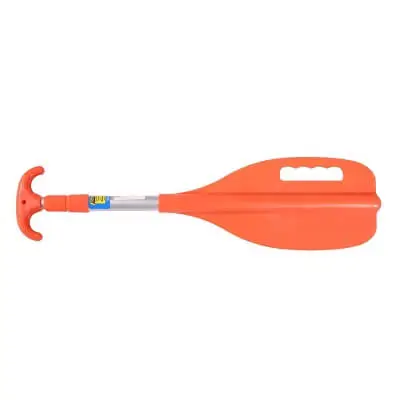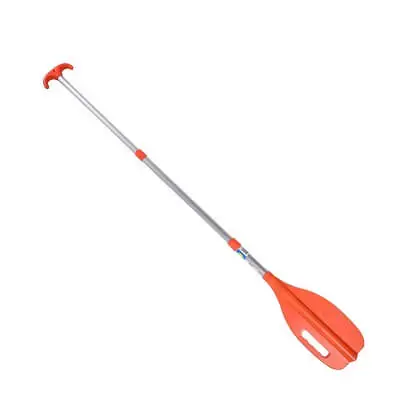Telescoping Paddle
Telescoping paddle is a specialized type of paddle designed for stand-up paddleboarding (SUP) that features an adjustable length mechanism. This innovative design allows paddleboarders to customize the length of their paddles based on individual preferences, height, and specific water conditions. Here is a detailed look at the key components and features.
Easily adapt to different lengths with a straightforward twist. The aluminum shaft conveniently retracts inside the blade, enabling compact storage beneath boat seats or in personal watercraft (PWC) compartments. The corrosion-resistant aluminum shaft, along with the high-impact molded blade and boat hook handle, is complemented by a hassle-free locking device.

Product Information
| Item Package Dimensions: L x W x 2 | 25.5 x 7 x 2 inches |
| Package Weight | 0.82 Kilograms |
| Brand Name | AIRHEAD |
| Material | Aluminum |
| Sport Type | Boating |
| Store |
$26.98
Table of Contents
Description
A telescoping paddle is a versatile and adjustable paddle designed for stand-up paddleboarding (SUP) and other water sports. It features a collapsible design with multiple sections that can be extended or retracted, allowing users to easily customize the length of the paddle.
This adaptability is particularly advantageous for individuals of varying heights and preferences, ensuring a comfortable and efficient paddling experience. Telescoping paddles often incorporate locking mechanisms to secure the chosen length during use, providing stability on the water.
Constructed with materials like aluminum, fiberglass, or carbon fiber, these paddles are lightweight, durable, and resistant to corrosion. Their portable and space-saving design makes them suitable for easy transportation and storage, while the versatility of adjusting lengths caters to different paddleboarding activities, making them a popular choice among water sports enthusiasts.
Key Features Telescoping Paddle
Adjustable Length:
Telescoping paddles are designed with multiple sections that can be easily extended or retracted, allowing users to customize the length based on their height, paddling style, or water conditions.
Locking Mechanism:
These paddles typically incorporate a reliable locking mechanism, such as clasps, levers, or twist-lock systems, to secure the extended length. This ensures stability during paddling and prevents any unexpected adjustments.
Material Composition:
ften constructed with lightweight and durable materials like aluminum, fiberglass, or carbon fiber. This choice of materials ensures buoyancy, ease of handling, and resistance to corrosion.
Portability:
The telescoping design allows the paddle to be easily collapsed into a compact size. This feature enhances portability, making it convenient for transportation, storage under boat seats, or placement in personal watercraft (PWC) storage compartments.
Versatility:
Telescoping paddles are versatile tools suitable for various paddleboarding activities. Users can adapt the length to meet the specific demands of activities such as cruising on calm waters, riding waves, or engaging in fitness paddling.
Corrosion Resistance:
Many telescoping paddles feature corrosion-resistant materials, particularly in the shaft, to withstand exposure to water and ensure longevity in various aquatic environments.
Boat Hook Handle:
Some telescoping paddles come equipped with a boat hook handle, providing additional functionality for tasks such as grabbing onto buoys, pulling objects closer, or assisting in various water-related activities.
Hassle-Free Design:
Telescoping paddles are often designed with user convenience in mind. The hassle-free setup and adjustment make them suitable for both beginners and experienced paddleboarders.
These key features collectively contribute to the popularity of telescoping paddles, offering users a customizable, durable, and convenient tool for their stand-up paddleboarding adventures.

Components
- Shaft:
- The shaft is the main body of the telescoping paddle, typically constructed from materials like aluminum, fiberglass, or carbon fiber. It provides the structural support and determines the overall weight and durability of the paddle.
- Sections:
- Telescoping paddles consist of multiple sections that can be extended or retracted. These sections are designed to slide into one another, allowing users to adjust the length of the paddle based on their preferences or the specific requirements of the activity.
- Locking Mechanism:
- The locking mechanism is a crucial component that ensures the extended sections of the paddle remain securely in place during use. Common locking mechanisms include clasps, levers, or twist-lock systems, providing stability and preventing unintentional adjustments.
- Blade:
- The blade is the wide, flat portion at the end of the paddle that interacts with the water. It can be made from various materials, such as plastic, fiberglass, or nylon. The design and size of the blade influence the paddle’s efficiency and performance in the water.
- Handle:
- The handle is the part of the paddle that the user grips. It can come in various shapes and materials, offering comfort and control during paddling. Some telescoping paddles may feature ergonomic designs or additional functionalities, such as boat hook handles for versatility.
- Adjustment Mechanism:
- The adjustment mechanism allows users to alter the length of the paddle easily. Depending on the design, it could involve twisting, sliding, or other user-friendly methods to extend or retract the sections of the paddle.
- Collar or Ferrule:
- The collar or ferrule is the joint between the shaft and the blade. In telescoping paddles, it is a key component that facilitates the easy adjustment of the length while maintaining stability. It is often integrated with the locking mechanism.
- Grip or T-Grip:
- The grip or T-grip is the part of the handle that the user holds onto. It can have various shapes, including a traditional T-shape or an ergonomic grip, providing comfort and control during paddling.
Understanding these components helps users evaluate the quality, functionality, and overall design of telescoping paddles, enabling them to make informed choices based on their preferences and paddleboarding needs.
Pros and Cons of Telescoping Paddles
Pros
- Adjustability: The primary advantage of telescoping paddles is their adjustable length, allowing users to customize the paddle according to their height, preference, and the specific conditions of the water. This adaptability enhances comfort and efficiency during paddleboarding.
- Versatility: Telescoping paddles are versatile tools suitable for various paddleboarding activities. Users can easily adapt the length to meet the demands of different water conditions and paddleboarding styles, making them a practical choice for enthusiasts with diverse preferences.
- Portability: The collapsible design of telescoping paddles makes them highly portable. They can be easily stowed in compact spaces, such as under boat seats or in personal watercraft (PWC) storage compartments. This feature is advantageous for users who prioritize convenience and travel frequently with their paddleboards.
- Shared Usage: Telescoping paddles are ideal for shared usage scenarios. With a simple adjustment, the paddle can accommodate users of different heights, making it a cost-effective and practical choice for group activities, rental services, or families with multiple users.
- Storage Convenience: The ability to collapse the paddle to a compact size not only aids in portability but also simplifies storage. This is particularly beneficial for individuals with limited storage space at home or those who need to store multiple paddles.
Cons
- Weight: Depending on the materials used in their construction, telescoping paddles can sometimes be slightly heavier than fixed-length paddles. This may impact overall paddle weight and user fatigue during extended use.
- Mechanical Complexity: The adjustable mechanisms, such as twist-lock systems or clasps, can introduce mechanical complexity. While advancements have improved reliability, users may occasionally encounter issues with locking mechanisms, potentially affecting the stability of the paddle.
- Durability Concerns: Some telescoping paddles may face durability concerns over time, especially if exposed to harsh conditions or frequently adjusted. Users should choose paddles made from high-quality materials to mitigate this issue.
- Price: Telescoping paddles often come with a higher price tag compared to standard fixed-length paddles. The added technology and design for adjustability contribute to the increased cost.
- Performance Trade-offs: In certain paddleboarding scenarios, particularly high-performance activities, some users may argue that telescoping paddles could have subtle performance trade-offs compared to specialized fixed-length paddles designed for specific conditions.
Understanding these pros and cons can help individuals make informed decisions when choosing a telescoping paddle based on their specific needs and preferences.Conclusion
In conclusion, telescoping paddles stand out as versatile and adaptable tools that have significantly enhanced the paddleboarding experience. Their adjustable length feature allows users to customize the paddle to their specific preferences and varying water conditions, ensuring comfort and efficiency on the water. The inclusion of reliable locking mechanisms, durable materials, and ergonomic designs contributes to the overall functionality and user-friendly nature of telescoping paddles.
The portability of these paddles, facilitated by their collapsible design, has addressed practical concerns related to storage and transportation. This feature makes them particularly appealing to individuals who value convenience, travel frequently with their paddleboards, or have limited storage space. The shared usage capability further adds to their appeal, allowing multiple users to easily adjust the paddle to their preferred lengths, promoting inclusivity within paddleboarding communities.
While telescoping paddles offer a range of advantages, it is essential for users to be mindful of potential drawbacks, such as variations in weight, mechanical complexity, and durability concerns. Considering these factors allows individuals to make informed decisions based on their specific needs and preferences.
In essence, telescoping paddles have become integral components in the world of paddleboarding, providing a customizable, durable, and convenient solution for enthusiasts of all skill levels. As technology continues to advance, we can anticipate further refinements in design, addressing current limitations and contributing to the ongoing evolution of this exciting water sport.
FAQs
How do telescoping paddles adjust in length?
Telescoping paddles have a design that allows their sections to slide into one another, providing an adjustable length. The adjustment mechanism, often involving a twist-lock, clasp, or lever system, secures the chosen length in place during use.
What materials are telescoping paddles made from?
Telescoping paddles are commonly constructed from lightweight and durable materials such as aluminum, fiberglass, or carbon fiber. These materials contribute to the paddle’s buoyancy, durability, and resistance to corrosion.
What are the advantages of telescoping paddles?
Telescoping paddles offer several advantages, including adjustable length for personalized use, versatility for various paddleboarding activities, portability due to their collapsible design, and shared usage capabilities. They are suitable for users of different heights and preferences.
Its suitable for different water conditions?
Yes, telescoping paddles are versatile and can be adjusted to suit different water conditions. Whether you’re cruising on calm waters or navigating through waves, the ability to customize the paddle length makes it adaptable to various paddleboarding scenarios.
It Is suitable for beginners?
Yes, telescoping paddles are suitable for beginners due to their user-friendly design. The adjustable length allows beginners to find a comfortable paddle size, and the collapsible nature enhances ease of transportation and storage.
Its more expensive than fixed-length paddles?
Telescoping paddles often come with a slightly higher price tag due to their adjustable design and added features. The technology and materials used for the adjustable mechanism contribute to the increased cost.